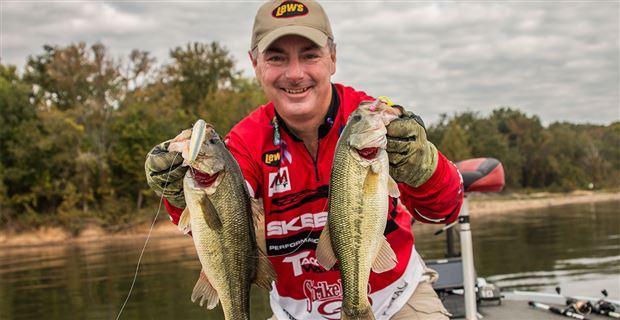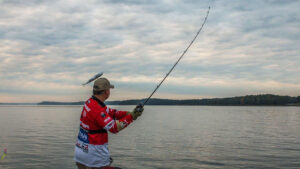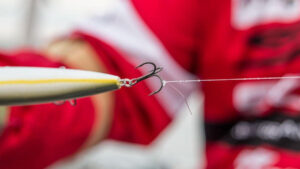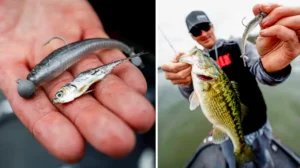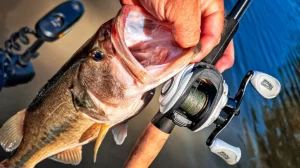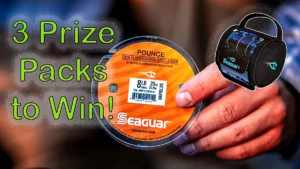Missed topwater strikes can make a grown man cry; we’ve all been there at some point in time. For years, bass fishermen have looked for a way to increase their hookup ratio when throwing larger topwater plugs and until recently, nobody’s had a great solution to it. We’ve accepted the missed opportunities as an unfortunate part of the proverbial game.
Elite Series pro Mark Menendez, however, has found a way to double his hookup ratio and, at times, catch multiple topwater bass on one cast. By attaching a simple grub trailer to his walking baits, he’s able to enjoy stellar topwater fishing in suprisingly tough conditions.
The advantages of the “two-timer rig”
Common logic would dictate that the more hooks that are in the water, the better your chances of catching bass. Menendez’s strategy, however, is much more than a numbers game.
“This particular rig allows you to show the bass a double presentation,” Menendez said. “You’re able to give them a main course and an appetizer, essentially. Depending upon forage size, type of fishery and forage species, it can be tough to zero in on exactly what the bass are feeding on most prevalently. The two-timer rig allows you to learn the feeding habits of your bass much quicker than a single lure will.”
Clean water is a major caveat of this strategy. This isn’t something that you’d throw in muddy water; it’s a very visual presentation that requires high visibility conditions.
“If the water is clear enough for a jerkbait, it’s clear enough for this rig,” Menendez said. “In other words, I’m looking for a minimum of 15 to 18 inches of water clarity. The big topwater plug, such as a Strike King Sexy Dawg, will draw the attention of these temperamental bass and as they come up to investigate it, the little grub or crappie jig acts as a little lollipop dangling right in their face. They can’t help but eat it.”
How to rig it
Fortunately, the two-timer rig is quite simple to create. You’ll need some monofilament line, an 1/8-ounce crappie fishing jighead, a small soft plastic and of course, a walking topwater lure.
“Similar to my water clarity, I like to use a 15 to 18-inch 12-pound Seaguar Senshi monofilament leader,” Menendez said. “This length doesn’t tangle too much and it allows for east lob casts, much like you’d make with an umbrella rig. I’ll use a standard Palomar knot to connect my Sexy Dawg to my 17-pound monofilament main line and connect my leader to the rear hook with a simple clinch knot.”
Versatility is a major advantage to this rig, especially in regards to trailer selection. Menendez uses an 1/8-ounce Mr. Crappie jighead regardless of the conditions, but he’s able to quickly change the color and style of his small soft plastic.
“You can use just about any soft plastic bait on that 1/8-ounce jighead and expect some bites; that’s the beautiful thing about it,” Menendez said. “But personally speaking, I’ve enjoyed most of my success using a 2-inch Rage Tail Grub, a Mr. Crappie Slabalicious and a Mr. Crappie ShadPole.”
Color selection is also quite simple. In sunny conditions, silver colors seem to work best due to the large amount of flash, while opaque colors tend to shine in overcast or lowlight conditions.
Bite detection and hooksets
When an aggressive bass hits your primary topwater plug, you can set the hook just like you would normally; with a stern sweep to the side. Bites on trailer, however, take more of a watchful eye to detect and catch.
EDITOR’S NOTE: Please check your local regulations, as some states may not allow multiple presentations on the same cast and/or line.
“Your primary lure is going to act just like a bobber for your trailer,” Menendez said. “It’s no different than bluegill fishing as a kid; when your plug gets pulled underwater, you know something has a hold of that trailer. Because you’re using such a lightwire aberdeen hook on that small jighead, a big hookset isn’t necessary. Just swing the rod to the side, much like setting the hook on a deep-diving crankbait.”
High-percentage applications
Spawn: When you’re dealing with the tail-end of the spawning season, the late-spawning females have a strong tendency to lay eggs towards the mouth of main pockets; they don’t always shoot straight to the backs.
“The two-timer rig is excellent for those oddball late spawners,” Menendez said. “These fish are absolute suckers for a bait sitting right on top of their beds. Just work it slowly and when you’re near the bed, stop your retrieve and let that topwater plug be a bobber until the ripples go away. You’ll be surprised how many big females you can catch this way.”
Post spawn: As the females slowly recover from the rigors of the spawning season, adding a bit of urgency and competition to your presentation can pay big dividends.
“After the spawn, I don’t really use any action at all when I’m fishing this rig,” Menendez said. “I’ll make a long cast and simply retrieve it back to the boat at a moderate pace. The plug is skipping across the surface and the trailer is darting behind it, just beneath the surface. It will get those lethargic post-spawners fired up and make them bite out of pure reaction instead of hunger.”
Shad spawn: While fast-moving, power fishing techniques such as spinnerbaits, single topwater plugs and swimbaits dominate during the meat of the shad spawn, the two-timer rig does an outstanding job at catching big bass during the awkward transition period that comes once the shad spawn is over.
“Once the freshly spawned shad move off the bank towards secondary cover such as small stick ups, tree tops and dock corners, this technique is really difficult to beat,” Menendez said. “During this period, the bass will almost behave as if they’re protecting bass fry, so it’s all about disturbing that ball of shad fry. The big plug spooks the group of fry and draws attention from nearby bass and that little ol’ trailer is just dangling right in front of them. You’ll get a lot of bites on that small trailer when this happens.”


